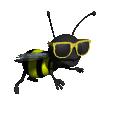The bees Eye view
 I have a very large interest in bees, so for my first blog post I've decided to research how bees see colors differently compared to humans. Through my research I have discovered that the color spectrum of bees is shifted when compared to the color spectrum of humans.
I have a very large interest in bees, so for my first blog post I've decided to research how bees see colors differently compared to humans. Through my research I have discovered that the color spectrum of bees is shifted when compared to the color spectrum of humans.
Visible light is part of a larger spectrum of energy. Bees can see ultraviolet – a color humans can only imagine – at the short-wavelength end of the spectrum. So it’s true that bees can see ‘colors’ we can’t. Many flowers have ultraviolet patterns on their petals, so bees can see these patterns. They use them as visual guides – like a map painted on the flower – directing them to the flower’s store of nectar. Some flowers that appear non-descript to us have strong ultraviolet patterns. Being a bee doesn’t necessarily mean you live in a more colorful world. Bees can’t see red – at the longer wavelength end of the spectrum – while humans can. To a bee, red looks black.
Humans see light in wavelengths from approximately 390 to 750 nanometers (nm). These wavelengths represent the spectrum of colors we can see. Bees, see from approximately 300 to 650 nm. That means they can’t see the color red, but they can see in the ultraviolet spectrum (which humans cannot). Bees can also easily distinguish between dark and light – making them very good at seeing edges. This helps them identify different shapes, though they can have trouble distinguishing between similar shapes that have smooth lines – such as circles and ovals. Vision is important to bees, because they feed on nectar and pollen – and that means they have to find flowers. Bees can use odor cues to find a perfect flower, but that only works when they’re already pretty close. Vision is essential to help the bees find flowers at a distance.
A bees Vision in responce to different colors:
Red -> black
Yellow -> yellow-green
Orange -> yellow-green (darker)
Green -> green
Blue -> blue plus ultraviolet blue
Violet -> blue plus ultra violet
Purple -> blue
White -> blue green
Black -> black
In conclusion, bees have a very unique color vision.
-
 2
2



7 Comments
Recommended Comments